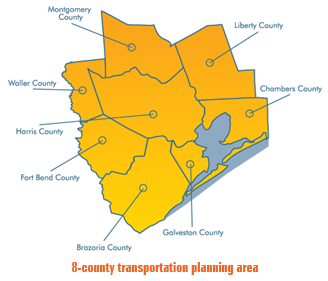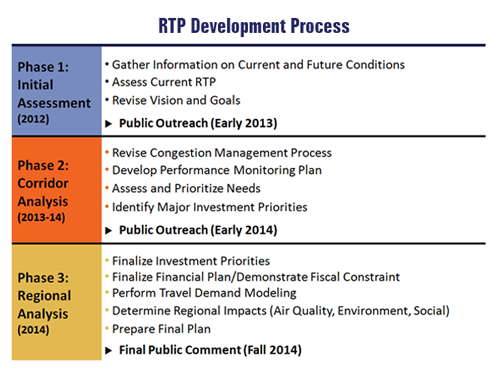On This Page
Decisions about how to spend transportation funds in a metropolitan region are guided by information and ideas from a broad group of people including elected officials, planners and engineers, transportation and other advocates, and other interested parties. The forum for this process is known as a metropolitan planning organization (MPO). Each metropolitan area in the United States with more than 50,000 residents has an MPO whose primary responsibility is to decide how to spend federal transportation funds for capital projects and planning studies.
MPO, H-GAC, TPC...What are all the acronyms?
Since 1974, the Houston-Galveston Area Council (H-GAC) and the Transportation Policy Council (TPC) have served as the MPO (staff and policy board, respectively) for the Houston transportation management area (Harris County and the seven surrounding counties: Montgomery, Liberty, Chambers, Galveston, Brazoria, Fort Bend and Waller). Together they provide policy guidance and overall coordination of the transportation planning activities within the region.

The TPC consists of 28 members representing cities and counties, the Texas Department of Transportation (TxDOT), the Metropolitan Transit Authority of Harris County (METRO), one at-large member appointed by the H-GAC Board of Directors, and one at-large member appointed by the TPC. The TPC is responsible for setting transportation policies and ultimately approving all funding decisions. It is assisted by several committees and subcommittees that are specialized by topic area to delve more deeply into technical matters.
Federal law requires the MPO’s work to be continuing, cooperative, and comprehensive – often referred to as the “3C process.” This process allows all voices to be heard and many different perspectives to be reconciled into plans for the region’s future. Developing the Regional Transportation Plan is part of this process. The MPO updates the RTP at least every four years.
How is the RTP updated?
The regional transportation plan is developed in three phases. An update usually means some portion(s) of the current RTP, such as planning horizon or demographic forecast, are not changed, while developing the RTP means that all portions of the previous plan are made current, modified or reviewed for continued accuracy.

Each phase concludes with a period to allow public feedback on the results of that phase. Keep in mind that transportation projects often takes years, even decades to plan, purchase the right-of-way, construct, and open for public use. Therefore, major changes to the Project List are done only after careful consideration.
What are other key transportation planning documents and where can I find them?
There are several other documents that guide or influence transportation planning.
Transportation Improvement Program
A short-range program of transportation improvements based on the long-range transportation plan. The TIP lists those projects that are to be funded and implemented in the next three to four years.
Public Participation Plan (PPP)
This plan outlines the overall strategy for public involvement in all transportation-related activities of the MPO. It spells out how and at what stages information is shared with the public, and how the public can provide input.
RTP Public Involvement Plan (RTP-PIP)
This plan outlines the specific public involvement strategies and steps used in the development of the Regional Transportation Plan (RTP).
Congestion Management Plan (CMP)
Areas with populations greater than 200,000 are designated as Transportation Management Areas (TMAs). TMAs must have a Congestion Management Plan that identifies actions and strategies to reduce congestion and increase mobility. The CMP includes a variety of strategies ranging from travel demand management techniques to the implementation of transit or bicycle and pedestrian facilities, and provides for the effective management of new and existing transportation facilities. The CMP is a part of the RTP.
State Implementation Plan (SIP)
Transportation plans, programs and projects must conform to the state’s air quality plan, known as the State Implementation Plan. A metropolitan area’s designation as an air quality nonattainment area (or maintenance area) creates additional requirements for transportation planning. As a nonattainment area, the Houston region must go through the transportation air quality conformity process. Conformity is a way to ensure that transportation plans and programs meet air quality goals to be eligible for federal funding and approval. Whenever the Regional Transportation Plan or the Transportation Improvement Program is amended or updated, the MPO must comply with conformity requirements.
Unified Planning Work Program
The UPWP serves as a guide for transportation and air quality planning activities to be conducted by the MPO over a two-year period. Included in the UPWP are detailed descriptions of the transportation and air quality planning tasks and a summary of the amount and source of State and Federal funds to be used for planning activities.

